Visitor Attraction Management Report: Economic Impact and Strategies
VerifiedAdded on 2023/01/17
|13
|4333
|24
Report
AI Summary
This report delves into the multifaceted realm of visitor attraction management, commencing with a comprehensive introduction that defines the core concepts and significance of the field. The report is structured around key learning objectives (LOs), beginning with an exploration of visitor attraction classifications and their impact on economic growth. It then transitions to an examination of visitor needs and motivations, followed by a discussion of the positive and negative impacts of tourism. The report further investigates feasibility studies for new attractions and existing ones, considering market demand, competition, and financial viability. Finally, it culminates in an analysis of visitor management strategies. The report uses the example of London's tourism industry to illustrate these concepts, highlighting the importance of promotional agencies and the diverse range of visitor attractions. The report also discusses the socio-economic and environmental impacts of tourism, providing a balanced perspective on the industry.
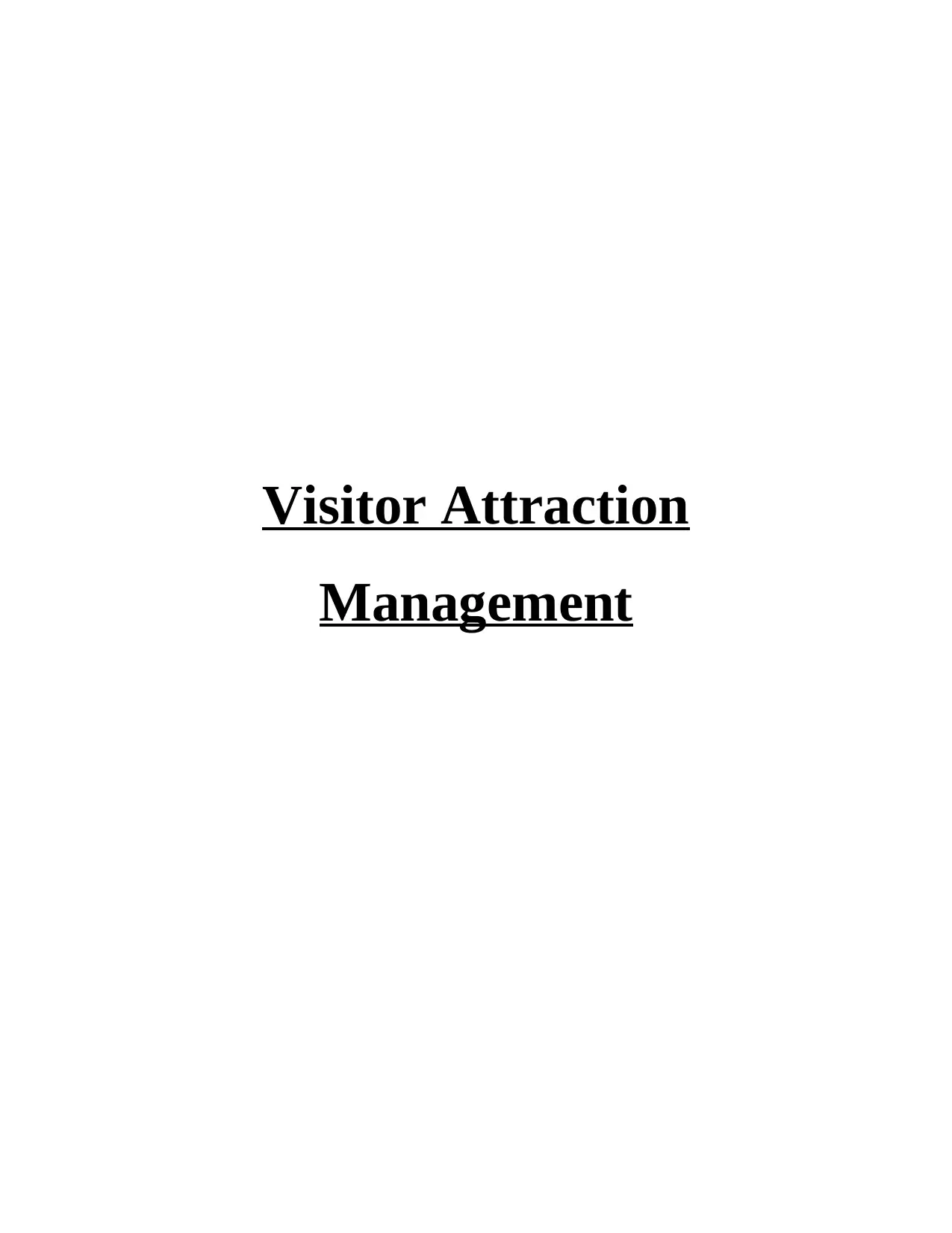
Visitor Attraction
Management
Management
Paraphrase This Document
Need a fresh take? Get an instant paraphrase of this document with our AI Paraphraser
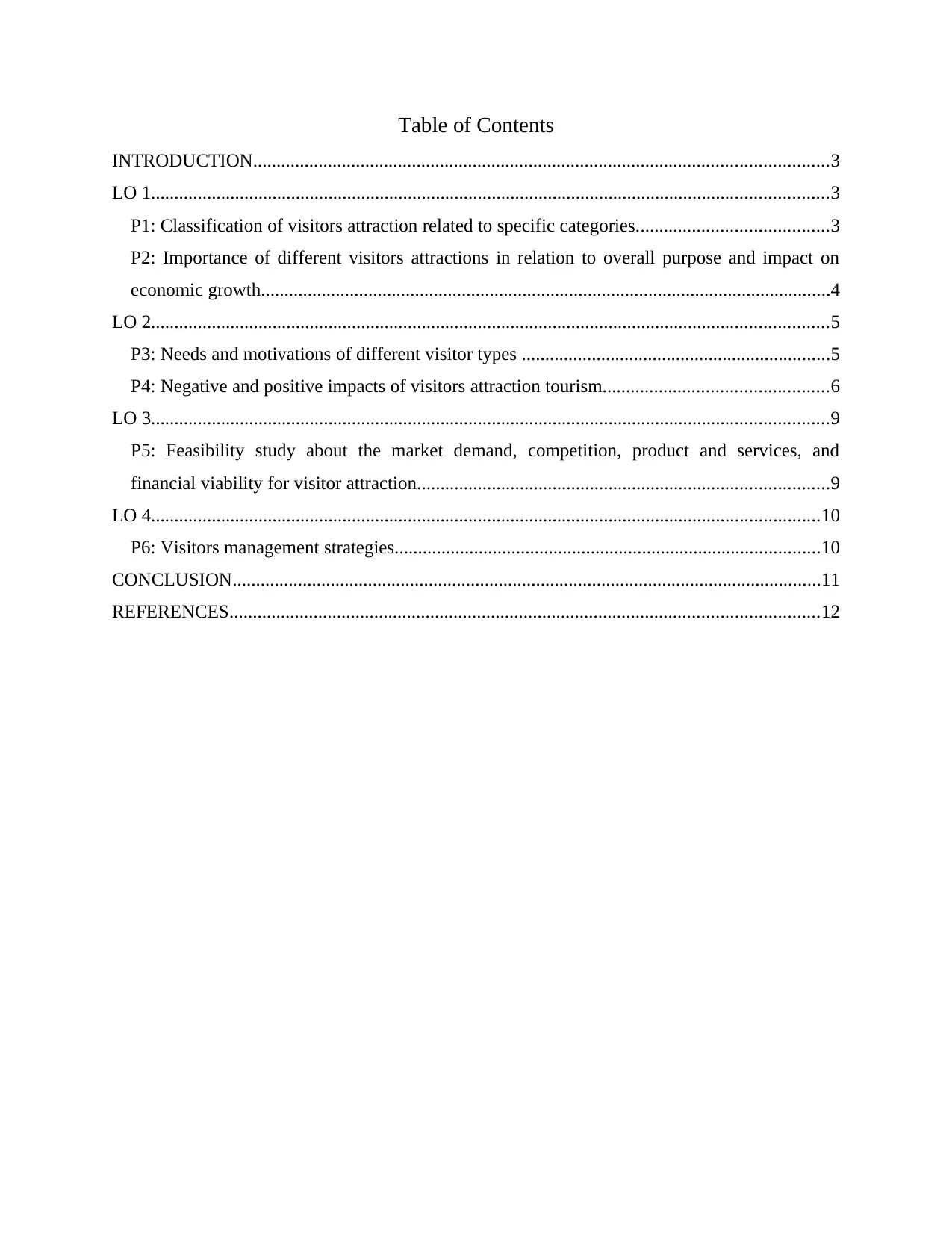
Table of Contents
INTRODUCTION...........................................................................................................................3
LO 1.................................................................................................................................................3
P1: Classification of visitors attraction related to specific categories.........................................3
P2: Importance of different visitors attractions in relation to overall purpose and impact on
economic growth..........................................................................................................................4
LO 2.................................................................................................................................................5
P3: Needs and motivations of different visitor types ..................................................................5
P4: Negative and positive impacts of visitors attraction tourism................................................6
LO 3.................................................................................................................................................9
P5: Feasibility study about the market demand, competition, product and services, and
financial viability for visitor attraction........................................................................................9
LO 4...............................................................................................................................................10
P6: Visitors management strategies...........................................................................................10
CONCLUSION..............................................................................................................................11
REFERENCES..............................................................................................................................12
INTRODUCTION...........................................................................................................................3
LO 1.................................................................................................................................................3
P1: Classification of visitors attraction related to specific categories.........................................3
P2: Importance of different visitors attractions in relation to overall purpose and impact on
economic growth..........................................................................................................................4
LO 2.................................................................................................................................................5
P3: Needs and motivations of different visitor types ..................................................................5
P4: Negative and positive impacts of visitors attraction tourism................................................6
LO 3.................................................................................................................................................9
P5: Feasibility study about the market demand, competition, product and services, and
financial viability for visitor attraction........................................................................................9
LO 4...............................................................................................................................................10
P6: Visitors management strategies...........................................................................................10
CONCLUSION..............................................................................................................................11
REFERENCES..............................................................................................................................12
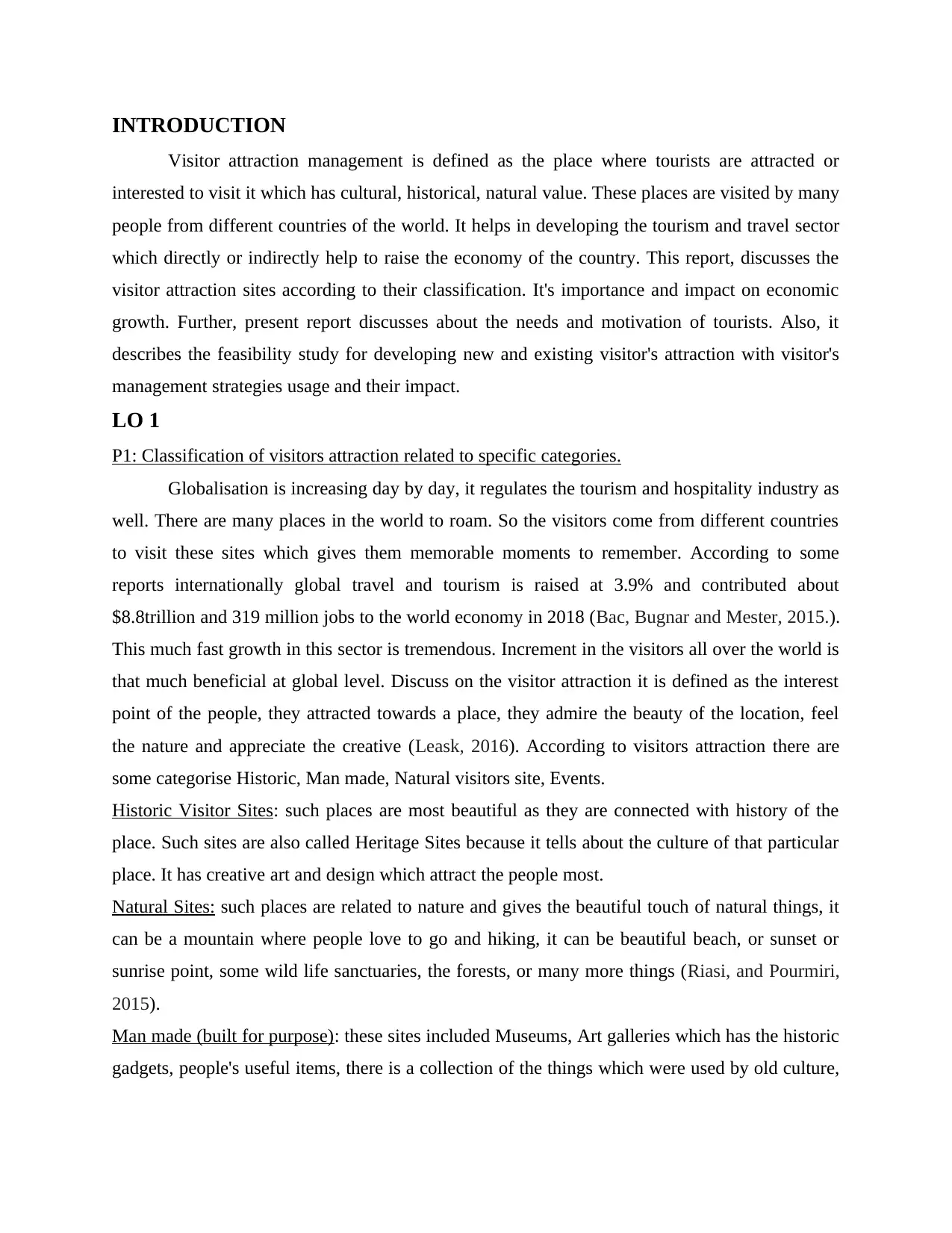
INTRODUCTION
Visitor attraction management is defined as the place where tourists are attracted or
interested to visit it which has cultural, historical, natural value. These places are visited by many
people from different countries of the world. It helps in developing the tourism and travel sector
which directly or indirectly help to raise the economy of the country. This report, discusses the
visitor attraction sites according to their classification. It's importance and impact on economic
growth. Further, present report discusses about the needs and motivation of tourists. Also, it
describes the feasibility study for developing new and existing visitor's attraction with visitor's
management strategies usage and their impact.
LO 1
P1: Classification of visitors attraction related to specific categories.
Globalisation is increasing day by day, it regulates the tourism and hospitality industry as
well. There are many places in the world to roam. So the visitors come from different countries
to visit these sites which gives them memorable moments to remember. According to some
reports internationally global travel and tourism is raised at 3.9% and contributed about
$8.8trillion and 319 million jobs to the world economy in 2018 (Bac, Bugnar and Mester, 2015.).
This much fast growth in this sector is tremendous. Increment in the visitors all over the world is
that much beneficial at global level. Discuss on the visitor attraction it is defined as the interest
point of the people, they attracted towards a place, they admire the beauty of the location, feel
the nature and appreciate the creative (Leask, 2016). According to visitors attraction there are
some categorise Historic, Man made, Natural visitors site, Events.
Historic Visitor Sites: such places are most beautiful as they are connected with history of the
place. Such sites are also called Heritage Sites because it tells about the culture of that particular
place. It has creative art and design which attract the people most.
Natural Sites: such places are related to nature and gives the beautiful touch of natural things, it
can be a mountain where people love to go and hiking, it can be beautiful beach, or sunset or
sunrise point, some wild life sanctuaries, the forests, or many more things (Riasi, and Pourmiri,
2015).
Man made (built for purpose): these sites included Museums, Art galleries which has the historic
gadgets, people's useful items, there is a collection of the things which were used by old culture,
Visitor attraction management is defined as the place where tourists are attracted or
interested to visit it which has cultural, historical, natural value. These places are visited by many
people from different countries of the world. It helps in developing the tourism and travel sector
which directly or indirectly help to raise the economy of the country. This report, discusses the
visitor attraction sites according to their classification. It's importance and impact on economic
growth. Further, present report discusses about the needs and motivation of tourists. Also, it
describes the feasibility study for developing new and existing visitor's attraction with visitor's
management strategies usage and their impact.
LO 1
P1: Classification of visitors attraction related to specific categories.
Globalisation is increasing day by day, it regulates the tourism and hospitality industry as
well. There are many places in the world to roam. So the visitors come from different countries
to visit these sites which gives them memorable moments to remember. According to some
reports internationally global travel and tourism is raised at 3.9% and contributed about
$8.8trillion and 319 million jobs to the world economy in 2018 (Bac, Bugnar and Mester, 2015.).
This much fast growth in this sector is tremendous. Increment in the visitors all over the world is
that much beneficial at global level. Discuss on the visitor attraction it is defined as the interest
point of the people, they attracted towards a place, they admire the beauty of the location, feel
the nature and appreciate the creative (Leask, 2016). According to visitors attraction there are
some categorise Historic, Man made, Natural visitors site, Events.
Historic Visitor Sites: such places are most beautiful as they are connected with history of the
place. Such sites are also called Heritage Sites because it tells about the culture of that particular
place. It has creative art and design which attract the people most.
Natural Sites: such places are related to nature and gives the beautiful touch of natural things, it
can be a mountain where people love to go and hiking, it can be beautiful beach, or sunset or
sunrise point, some wild life sanctuaries, the forests, or many more things (Riasi, and Pourmiri,
2015).
Man made (built for purpose): these sites included Museums, Art galleries which has the historic
gadgets, people's useful items, there is a collection of the things which were used by old culture,
⊘ This is a preview!⊘
Do you want full access?
Subscribe today to unlock all pages.

Trusted by 1+ million students worldwide
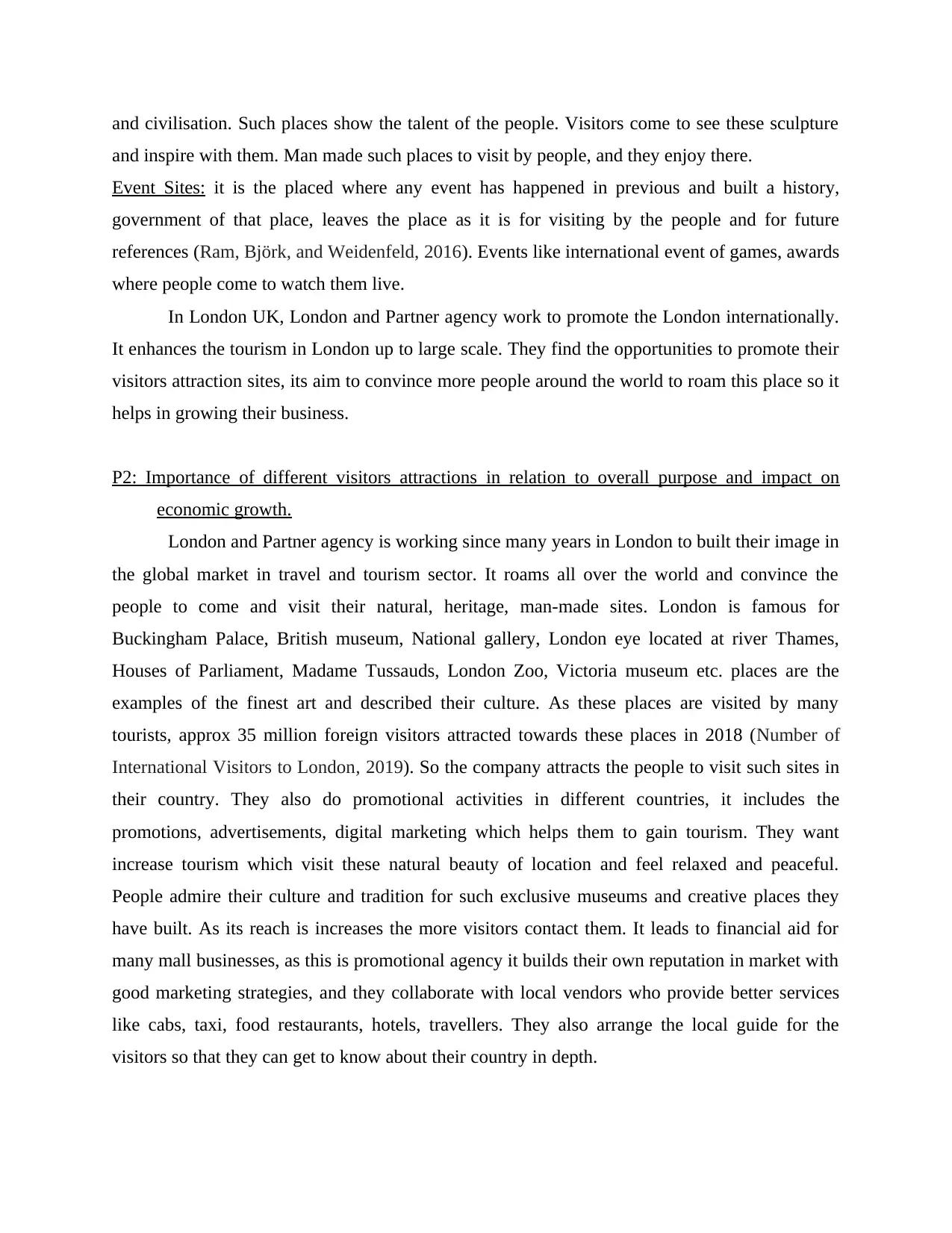
and civilisation. Such places show the talent of the people. Visitors come to see these sculpture
and inspire with them. Man made such places to visit by people, and they enjoy there.
Event Sites: it is the placed where any event has happened in previous and built a history,
government of that place, leaves the place as it is for visiting by the people and for future
references (Ram, Björk, and Weidenfeld, 2016). Events like international event of games, awards
where people come to watch them live.
In London UK, London and Partner agency work to promote the London internationally.
It enhances the tourism in London up to large scale. They find the opportunities to promote their
visitors attraction sites, its aim to convince more people around the world to roam this place so it
helps in growing their business.
P2: Importance of different visitors attractions in relation to overall purpose and impact on
economic growth.
London and Partner agency is working since many years in London to built their image in
the global market in travel and tourism sector. It roams all over the world and convince the
people to come and visit their natural, heritage, man-made sites. London is famous for
Buckingham Palace, British museum, National gallery, London eye located at river Thames,
Houses of Parliament, Madame Tussauds, London Zoo, Victoria museum etc. places are the
examples of the finest art and described their culture. As these places are visited by many
tourists, approx 35 million foreign visitors attracted towards these places in 2018 (Number of
International Visitors to London, 2019). So the company attracts the people to visit such sites in
their country. They also do promotional activities in different countries, it includes the
promotions, advertisements, digital marketing which helps them to gain tourism. They want
increase tourism which visit these natural beauty of location and feel relaxed and peaceful.
People admire their culture and tradition for such exclusive museums and creative places they
have built. As its reach is increases the more visitors contact them. It leads to financial aid for
many mall businesses, as this is promotional agency it builds their own reputation in market with
good marketing strategies, and they collaborate with local vendors who provide better services
like cabs, taxi, food restaurants, hotels, travellers. They also arrange the local guide for the
visitors so that they can get to know about their country in depth.
and inspire with them. Man made such places to visit by people, and they enjoy there.
Event Sites: it is the placed where any event has happened in previous and built a history,
government of that place, leaves the place as it is for visiting by the people and for future
references (Ram, Björk, and Weidenfeld, 2016). Events like international event of games, awards
where people come to watch them live.
In London UK, London and Partner agency work to promote the London internationally.
It enhances the tourism in London up to large scale. They find the opportunities to promote their
visitors attraction sites, its aim to convince more people around the world to roam this place so it
helps in growing their business.
P2: Importance of different visitors attractions in relation to overall purpose and impact on
economic growth.
London and Partner agency is working since many years in London to built their image in
the global market in travel and tourism sector. It roams all over the world and convince the
people to come and visit their natural, heritage, man-made sites. London is famous for
Buckingham Palace, British museum, National gallery, London eye located at river Thames,
Houses of Parliament, Madame Tussauds, London Zoo, Victoria museum etc. places are the
examples of the finest art and described their culture. As these places are visited by many
tourists, approx 35 million foreign visitors attracted towards these places in 2018 (Number of
International Visitors to London, 2019). So the company attracts the people to visit such sites in
their country. They also do promotional activities in different countries, it includes the
promotions, advertisements, digital marketing which helps them to gain tourism. They want
increase tourism which visit these natural beauty of location and feel relaxed and peaceful.
People admire their culture and tradition for such exclusive museums and creative places they
have built. As its reach is increases the more visitors contact them. It leads to financial aid for
many mall businesses, as this is promotional agency it builds their own reputation in market with
good marketing strategies, and they collaborate with local vendors who provide better services
like cabs, taxi, food restaurants, hotels, travellers. They also arrange the local guide for the
visitors so that they can get to know about their country in depth.
Paraphrase This Document
Need a fresh take? Get an instant paraphrase of this document with our AI Paraphraser
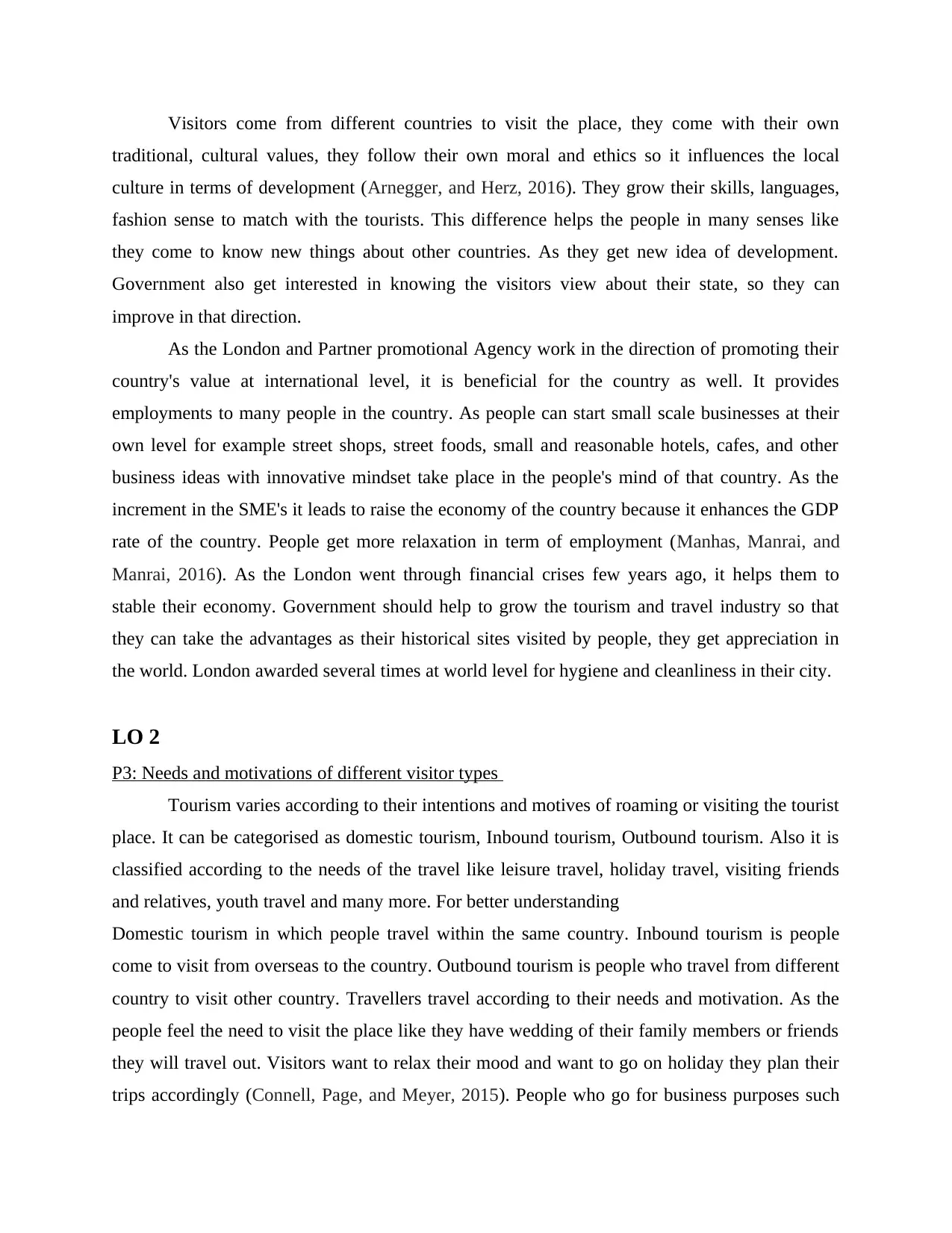
Visitors come from different countries to visit the place, they come with their own
traditional, cultural values, they follow their own moral and ethics so it influences the local
culture in terms of development (Arnegger, and Herz, 2016). They grow their skills, languages,
fashion sense to match with the tourists. This difference helps the people in many senses like
they come to know new things about other countries. As they get new idea of development.
Government also get interested in knowing the visitors view about their state, so they can
improve in that direction.
As the London and Partner promotional Agency work in the direction of promoting their
country's value at international level, it is beneficial for the country as well. It provides
employments to many people in the country. As people can start small scale businesses at their
own level for example street shops, street foods, small and reasonable hotels, cafes, and other
business ideas with innovative mindset take place in the people's mind of that country. As the
increment in the SME's it leads to raise the economy of the country because it enhances the GDP
rate of the country. People get more relaxation in term of employment (Manhas, Manrai, and
Manrai, 2016). As the London went through financial crises few years ago, it helps them to
stable their economy. Government should help to grow the tourism and travel industry so that
they can take the advantages as their historical sites visited by people, they get appreciation in
the world. London awarded several times at world level for hygiene and cleanliness in their city.
LO 2
P3: Needs and motivations of different visitor types
Tourism varies according to their intentions and motives of roaming or visiting the tourist
place. It can be categorised as domestic tourism, Inbound tourism, Outbound tourism. Also it is
classified according to the needs of the travel like leisure travel, holiday travel, visiting friends
and relatives, youth travel and many more. For better understanding
Domestic tourism in which people travel within the same country. Inbound tourism is people
come to visit from overseas to the country. Outbound tourism is people who travel from different
country to visit other country. Travellers travel according to their needs and motivation. As the
people feel the need to visit the place like they have wedding of their family members or friends
they will travel out. Visitors want to relax their mood and want to go on holiday they plan their
trips accordingly (Connell, Page, and Meyer, 2015). People who go for business purposes such
traditional, cultural values, they follow their own moral and ethics so it influences the local
culture in terms of development (Arnegger, and Herz, 2016). They grow their skills, languages,
fashion sense to match with the tourists. This difference helps the people in many senses like
they come to know new things about other countries. As they get new idea of development.
Government also get interested in knowing the visitors view about their state, so they can
improve in that direction.
As the London and Partner promotional Agency work in the direction of promoting their
country's value at international level, it is beneficial for the country as well. It provides
employments to many people in the country. As people can start small scale businesses at their
own level for example street shops, street foods, small and reasonable hotels, cafes, and other
business ideas with innovative mindset take place in the people's mind of that country. As the
increment in the SME's it leads to raise the economy of the country because it enhances the GDP
rate of the country. People get more relaxation in term of employment (Manhas, Manrai, and
Manrai, 2016). As the London went through financial crises few years ago, it helps them to
stable their economy. Government should help to grow the tourism and travel industry so that
they can take the advantages as their historical sites visited by people, they get appreciation in
the world. London awarded several times at world level for hygiene and cleanliness in their city.
LO 2
P3: Needs and motivations of different visitor types
Tourism varies according to their intentions and motives of roaming or visiting the tourist
place. It can be categorised as domestic tourism, Inbound tourism, Outbound tourism. Also it is
classified according to the needs of the travel like leisure travel, holiday travel, visiting friends
and relatives, youth travel and many more. For better understanding
Domestic tourism in which people travel within the same country. Inbound tourism is people
come to visit from overseas to the country. Outbound tourism is people who travel from different
country to visit other country. Travellers travel according to their needs and motivation. As the
people feel the need to visit the place like they have wedding of their family members or friends
they will travel out. Visitors want to relax their mood and want to go on holiday they plan their
trips accordingly (Connell, Page, and Meyer, 2015). People who go for business purposes such
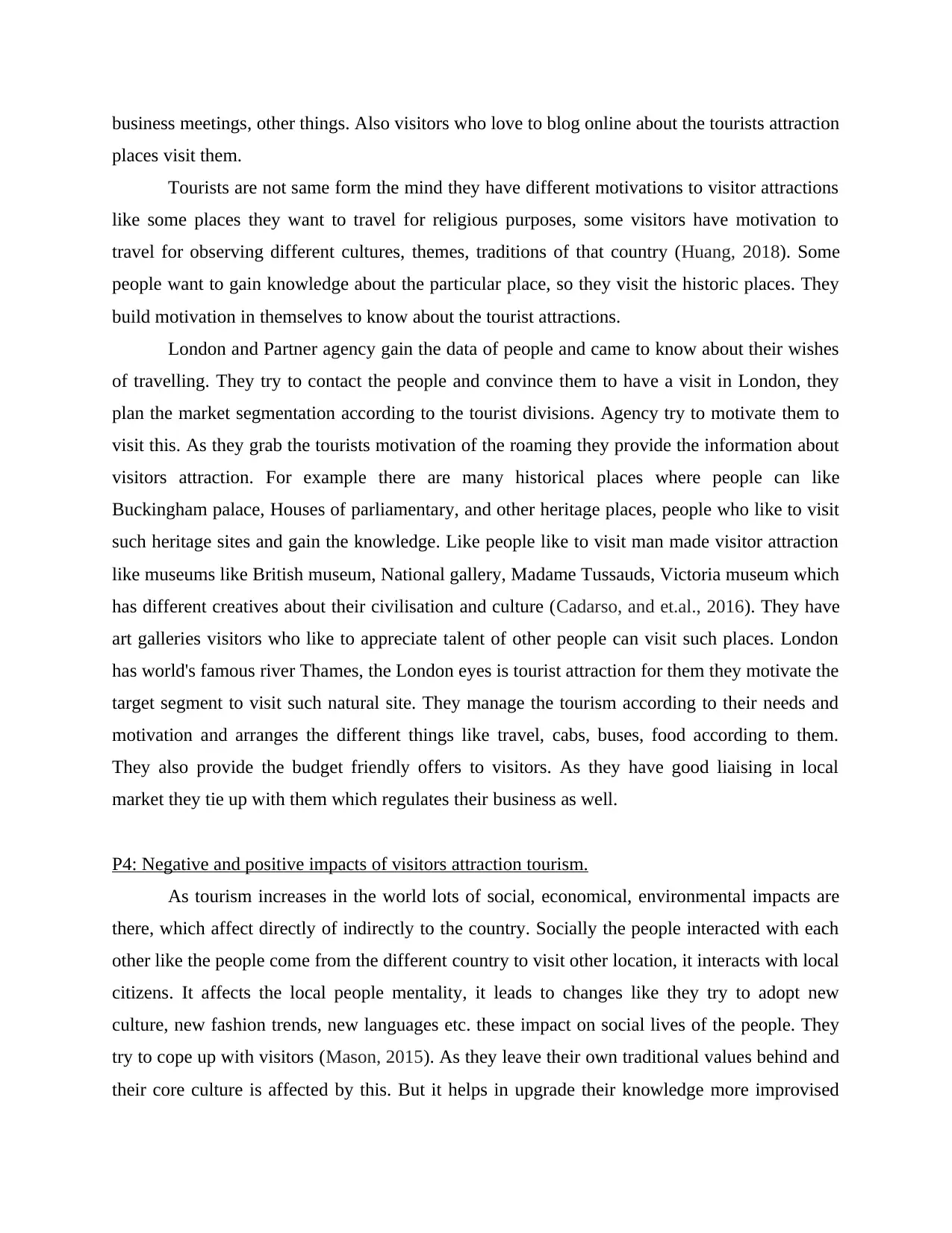
business meetings, other things. Also visitors who love to blog online about the tourists attraction
places visit them.
Tourists are not same form the mind they have different motivations to visitor attractions
like some places they want to travel for religious purposes, some visitors have motivation to
travel for observing different cultures, themes, traditions of that country (Huang, 2018). Some
people want to gain knowledge about the particular place, so they visit the historic places. They
build motivation in themselves to know about the tourist attractions.
London and Partner agency gain the data of people and came to know about their wishes
of travelling. They try to contact the people and convince them to have a visit in London, they
plan the market segmentation according to the tourist divisions. Agency try to motivate them to
visit this. As they grab the tourists motivation of the roaming they provide the information about
visitors attraction. For example there are many historical places where people can like
Buckingham palace, Houses of parliamentary, and other heritage places, people who like to visit
such heritage sites and gain the knowledge. Like people like to visit man made visitor attraction
like museums like British museum, National gallery, Madame Tussauds, Victoria museum which
has different creatives about their civilisation and culture (Cadarso, and et.al., 2016). They have
art galleries visitors who like to appreciate talent of other people can visit such places. London
has world's famous river Thames, the London eyes is tourist attraction for them they motivate the
target segment to visit such natural site. They manage the tourism according to their needs and
motivation and arranges the different things like travel, cabs, buses, food according to them.
They also provide the budget friendly offers to visitors. As they have good liaising in local
market they tie up with them which regulates their business as well.
P4: Negative and positive impacts of visitors attraction tourism.
As tourism increases in the world lots of social, economical, environmental impacts are
there, which affect directly of indirectly to the country. Socially the people interacted with each
other like the people come from the different country to visit other location, it interacts with local
citizens. It affects the local people mentality, it leads to changes like they try to adopt new
culture, new fashion trends, new languages etc. these impact on social lives of the people. They
try to cope up with visitors (Mason, 2015). As they leave their own traditional values behind and
their core culture is affected by this. But it helps in upgrade their knowledge more improvised
places visit them.
Tourists are not same form the mind they have different motivations to visitor attractions
like some places they want to travel for religious purposes, some visitors have motivation to
travel for observing different cultures, themes, traditions of that country (Huang, 2018). Some
people want to gain knowledge about the particular place, so they visit the historic places. They
build motivation in themselves to know about the tourist attractions.
London and Partner agency gain the data of people and came to know about their wishes
of travelling. They try to contact the people and convince them to have a visit in London, they
plan the market segmentation according to the tourist divisions. Agency try to motivate them to
visit this. As they grab the tourists motivation of the roaming they provide the information about
visitors attraction. For example there are many historical places where people can like
Buckingham palace, Houses of parliamentary, and other heritage places, people who like to visit
such heritage sites and gain the knowledge. Like people like to visit man made visitor attraction
like museums like British museum, National gallery, Madame Tussauds, Victoria museum which
has different creatives about their civilisation and culture (Cadarso, and et.al., 2016). They have
art galleries visitors who like to appreciate talent of other people can visit such places. London
has world's famous river Thames, the London eyes is tourist attraction for them they motivate the
target segment to visit such natural site. They manage the tourism according to their needs and
motivation and arranges the different things like travel, cabs, buses, food according to them.
They also provide the budget friendly offers to visitors. As they have good liaising in local
market they tie up with them which regulates their business as well.
P4: Negative and positive impacts of visitors attraction tourism.
As tourism increases in the world lots of social, economical, environmental impacts are
there, which affect directly of indirectly to the country. Socially the people interacted with each
other like the people come from the different country to visit other location, it interacts with local
citizens. It affects the local people mentality, it leads to changes like they try to adopt new
culture, new fashion trends, new languages etc. these impact on social lives of the people. They
try to cope up with visitors (Mason, 2015). As they leave their own traditional values behind and
their core culture is affected by this. But it helps in upgrade their knowledge more improvised
⊘ This is a preview!⊘
Do you want full access?
Subscribe today to unlock all pages.

Trusted by 1+ million students worldwide
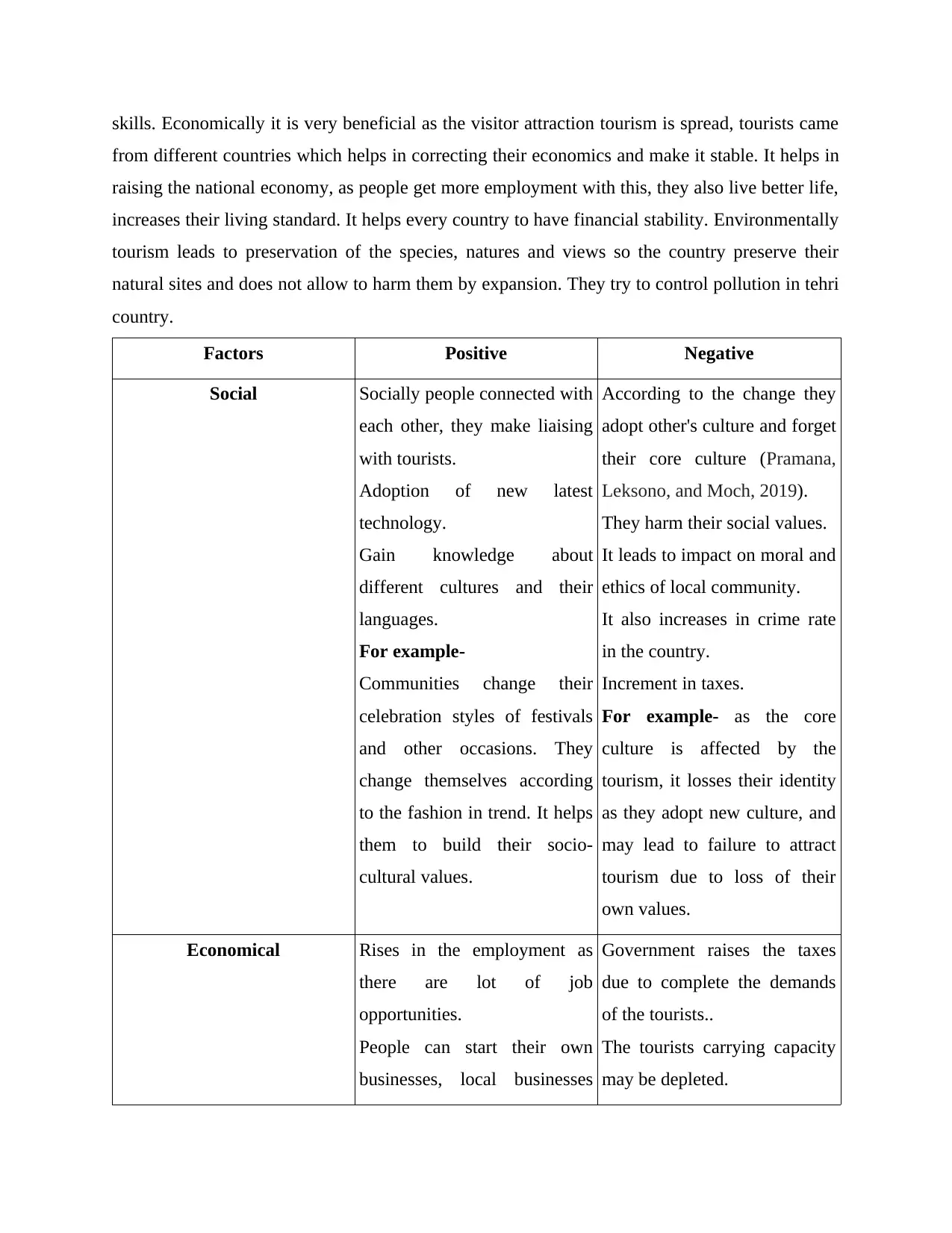
skills. Economically it is very beneficial as the visitor attraction tourism is spread, tourists came
from different countries which helps in correcting their economics and make it stable. It helps in
raising the national economy, as people get more employment with this, they also live better life,
increases their living standard. It helps every country to have financial stability. Environmentally
tourism leads to preservation of the species, natures and views so the country preserve their
natural sites and does not allow to harm them by expansion. They try to control pollution in tehri
country.
Factors Positive Negative
Social Socially people connected with
each other, they make liaising
with tourists.
Adoption of new latest
technology.
Gain knowledge about
different cultures and their
languages.
For example-
Communities change their
celebration styles of festivals
and other occasions. They
change themselves according
to the fashion in trend. It helps
them to build their socio-
cultural values.
According to the change they
adopt other's culture and forget
their core culture (Pramana,
Leksono, and Moch, 2019).
They harm their social values.
It leads to impact on moral and
ethics of local community.
It also increases in crime rate
in the country.
Increment in taxes.
For example- as the core
culture is affected by the
tourism, it losses their identity
as they adopt new culture, and
may lead to failure to attract
tourism due to loss of their
own values.
Economical Rises in the employment as
there are lot of job
opportunities.
People can start their own
businesses, local businesses
Government raises the taxes
due to complete the demands
of the tourists..
The tourists carrying capacity
may be depleted.
from different countries which helps in correcting their economics and make it stable. It helps in
raising the national economy, as people get more employment with this, they also live better life,
increases their living standard. It helps every country to have financial stability. Environmentally
tourism leads to preservation of the species, natures and views so the country preserve their
natural sites and does not allow to harm them by expansion. They try to control pollution in tehri
country.
Factors Positive Negative
Social Socially people connected with
each other, they make liaising
with tourists.
Adoption of new latest
technology.
Gain knowledge about
different cultures and their
languages.
For example-
Communities change their
celebration styles of festivals
and other occasions. They
change themselves according
to the fashion in trend. It helps
them to build their socio-
cultural values.
According to the change they
adopt other's culture and forget
their core culture (Pramana,
Leksono, and Moch, 2019).
They harm their social values.
It leads to impact on moral and
ethics of local community.
It also increases in crime rate
in the country.
Increment in taxes.
For example- as the core
culture is affected by the
tourism, it losses their identity
as they adopt new culture, and
may lead to failure to attract
tourism due to loss of their
own values.
Economical Rises in the employment as
there are lot of job
opportunities.
People can start their own
businesses, local businesses
Government raises the taxes
due to complete the demands
of the tourists..
The tourists carrying capacity
may be depleted.
Paraphrase This Document
Need a fresh take? Get an instant paraphrase of this document with our AI Paraphraser
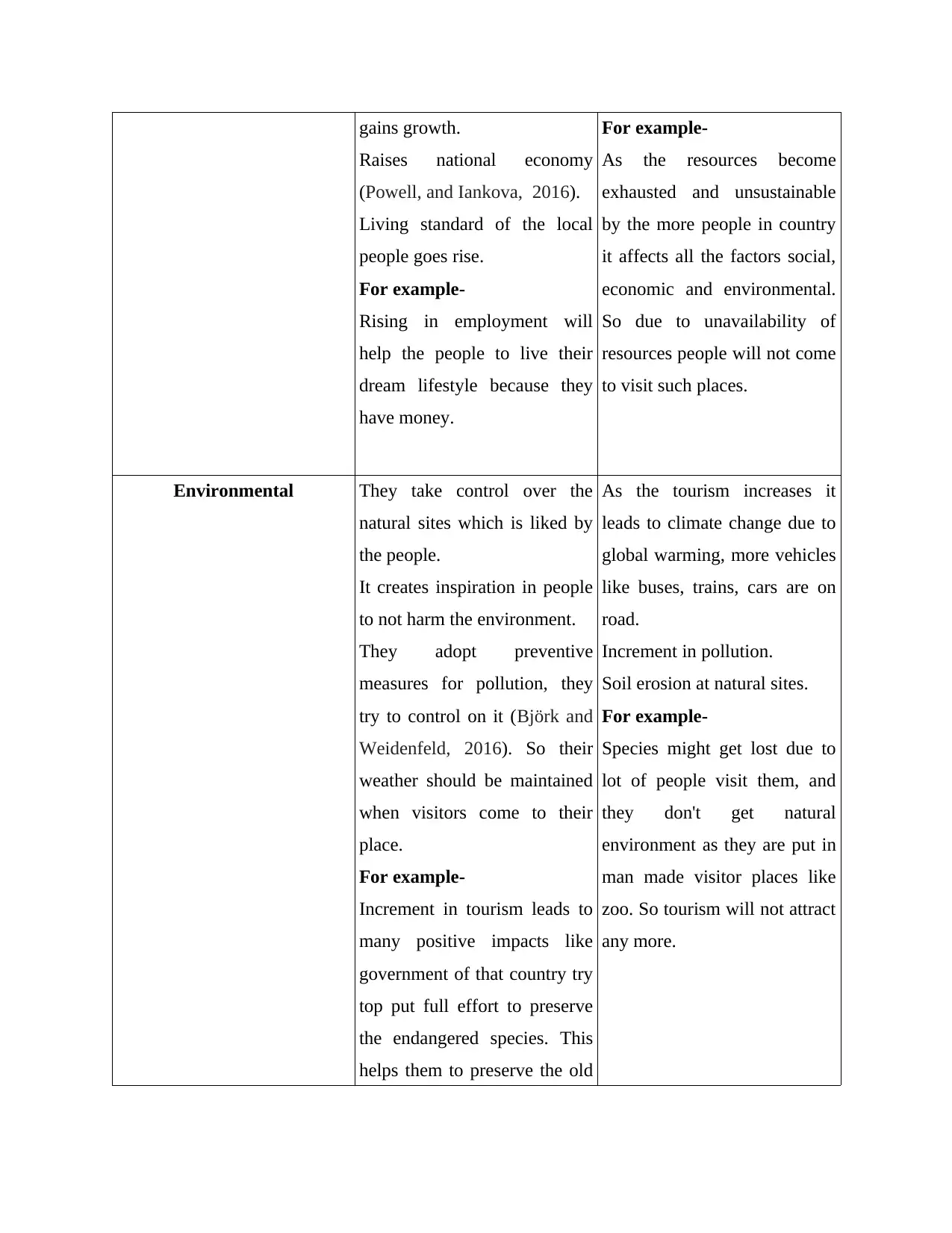
gains growth.
Raises national economy
(Powell, and Iankova, 2016).
Living standard of the local
people goes rise.
For example-
Rising in employment will
help the people to live their
dream lifestyle because they
have money.
For example-
As the resources become
exhausted and unsustainable
by the more people in country
it affects all the factors social,
economic and environmental.
So due to unavailability of
resources people will not come
to visit such places.
Environmental They take control over the
natural sites which is liked by
the people.
It creates inspiration in people
to not harm the environment.
They adopt preventive
measures for pollution, they
try to control on it (Björk and
Weidenfeld, 2016). So their
weather should be maintained
when visitors come to their
place.
For example-
Increment in tourism leads to
many positive impacts like
government of that country try
top put full effort to preserve
the endangered species. This
helps them to preserve the old
As the tourism increases it
leads to climate change due to
global warming, more vehicles
like buses, trains, cars are on
road.
Increment in pollution.
Soil erosion at natural sites.
For example-
Species might get lost due to
lot of people visit them, and
they don't get natural
environment as they are put in
man made visitor places like
zoo. So tourism will not attract
any more.
Raises national economy
(Powell, and Iankova, 2016).
Living standard of the local
people goes rise.
For example-
Rising in employment will
help the people to live their
dream lifestyle because they
have money.
For example-
As the resources become
exhausted and unsustainable
by the more people in country
it affects all the factors social,
economic and environmental.
So due to unavailability of
resources people will not come
to visit such places.
Environmental They take control over the
natural sites which is liked by
the people.
It creates inspiration in people
to not harm the environment.
They adopt preventive
measures for pollution, they
try to control on it (Björk and
Weidenfeld, 2016). So their
weather should be maintained
when visitors come to their
place.
For example-
Increment in tourism leads to
many positive impacts like
government of that country try
top put full effort to preserve
the endangered species. This
helps them to preserve the old
As the tourism increases it
leads to climate change due to
global warming, more vehicles
like buses, trains, cars are on
road.
Increment in pollution.
Soil erosion at natural sites.
For example-
Species might get lost due to
lot of people visit them, and
they don't get natural
environment as they are put in
man made visitor places like
zoo. So tourism will not attract
any more.
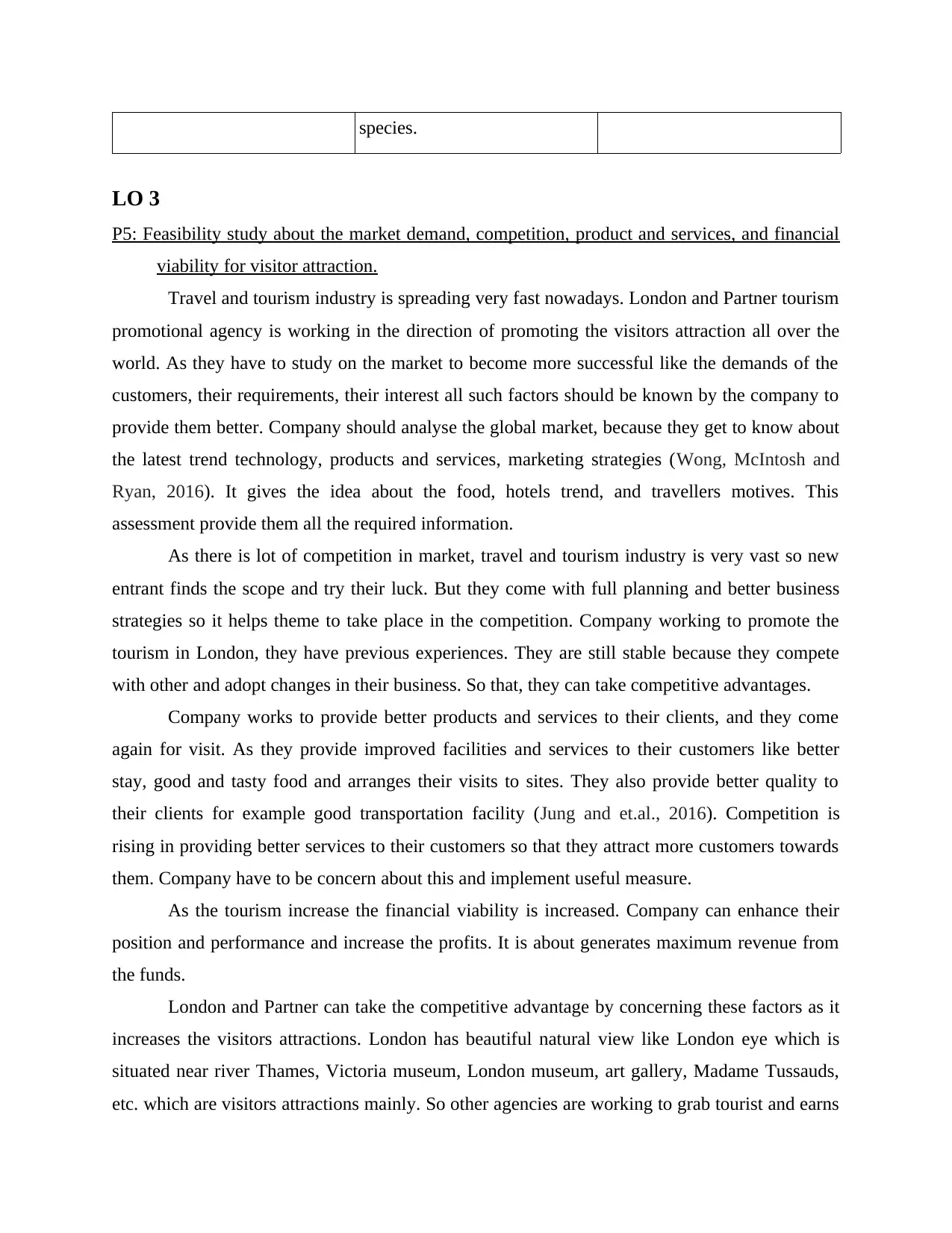
species.
LO 3
P5: Feasibility study about the market demand, competition, product and services, and financial
viability for visitor attraction.
Travel and tourism industry is spreading very fast nowadays. London and Partner tourism
promotional agency is working in the direction of promoting the visitors attraction all over the
world. As they have to study on the market to become more successful like the demands of the
customers, their requirements, their interest all such factors should be known by the company to
provide them better. Company should analyse the global market, because they get to know about
the latest trend technology, products and services, marketing strategies (Wong, McIntosh and
Ryan, 2016). It gives the idea about the food, hotels trend, and travellers motives. This
assessment provide them all the required information.
As there is lot of competition in market, travel and tourism industry is very vast so new
entrant finds the scope and try their luck. But they come with full planning and better business
strategies so it helps theme to take place in the competition. Company working to promote the
tourism in London, they have previous experiences. They are still stable because they compete
with other and adopt changes in their business. So that, they can take competitive advantages.
Company works to provide better products and services to their clients, and they come
again for visit. As they provide improved facilities and services to their customers like better
stay, good and tasty food and arranges their visits to sites. They also provide better quality to
their clients for example good transportation facility (Jung and et.al., 2016). Competition is
rising in providing better services to their customers so that they attract more customers towards
them. Company have to be concern about this and implement useful measure.
As the tourism increase the financial viability is increased. Company can enhance their
position and performance and increase the profits. It is about generates maximum revenue from
the funds.
London and Partner can take the competitive advantage by concerning these factors as it
increases the visitors attractions. London has beautiful natural view like London eye which is
situated near river Thames, Victoria museum, London museum, art gallery, Madame Tussauds,
etc. which are visitors attractions mainly. So other agencies are working to grab tourist and earns
LO 3
P5: Feasibility study about the market demand, competition, product and services, and financial
viability for visitor attraction.
Travel and tourism industry is spreading very fast nowadays. London and Partner tourism
promotional agency is working in the direction of promoting the visitors attraction all over the
world. As they have to study on the market to become more successful like the demands of the
customers, their requirements, their interest all such factors should be known by the company to
provide them better. Company should analyse the global market, because they get to know about
the latest trend technology, products and services, marketing strategies (Wong, McIntosh and
Ryan, 2016). It gives the idea about the food, hotels trend, and travellers motives. This
assessment provide them all the required information.
As there is lot of competition in market, travel and tourism industry is very vast so new
entrant finds the scope and try their luck. But they come with full planning and better business
strategies so it helps theme to take place in the competition. Company working to promote the
tourism in London, they have previous experiences. They are still stable because they compete
with other and adopt changes in their business. So that, they can take competitive advantages.
Company works to provide better products and services to their clients, and they come
again for visit. As they provide improved facilities and services to their customers like better
stay, good and tasty food and arranges their visits to sites. They also provide better quality to
their clients for example good transportation facility (Jung and et.al., 2016). Competition is
rising in providing better services to their customers so that they attract more customers towards
them. Company have to be concern about this and implement useful measure.
As the tourism increase the financial viability is increased. Company can enhance their
position and performance and increase the profits. It is about generates maximum revenue from
the funds.
London and Partner can take the competitive advantage by concerning these factors as it
increases the visitors attractions. London has beautiful natural view like London eye which is
situated near river Thames, Victoria museum, London museum, art gallery, Madame Tussauds,
etc. which are visitors attractions mainly. So other agencies are working to grab tourist and earns
⊘ This is a preview!⊘
Do you want full access?
Subscribe today to unlock all pages.

Trusted by 1+ million students worldwide
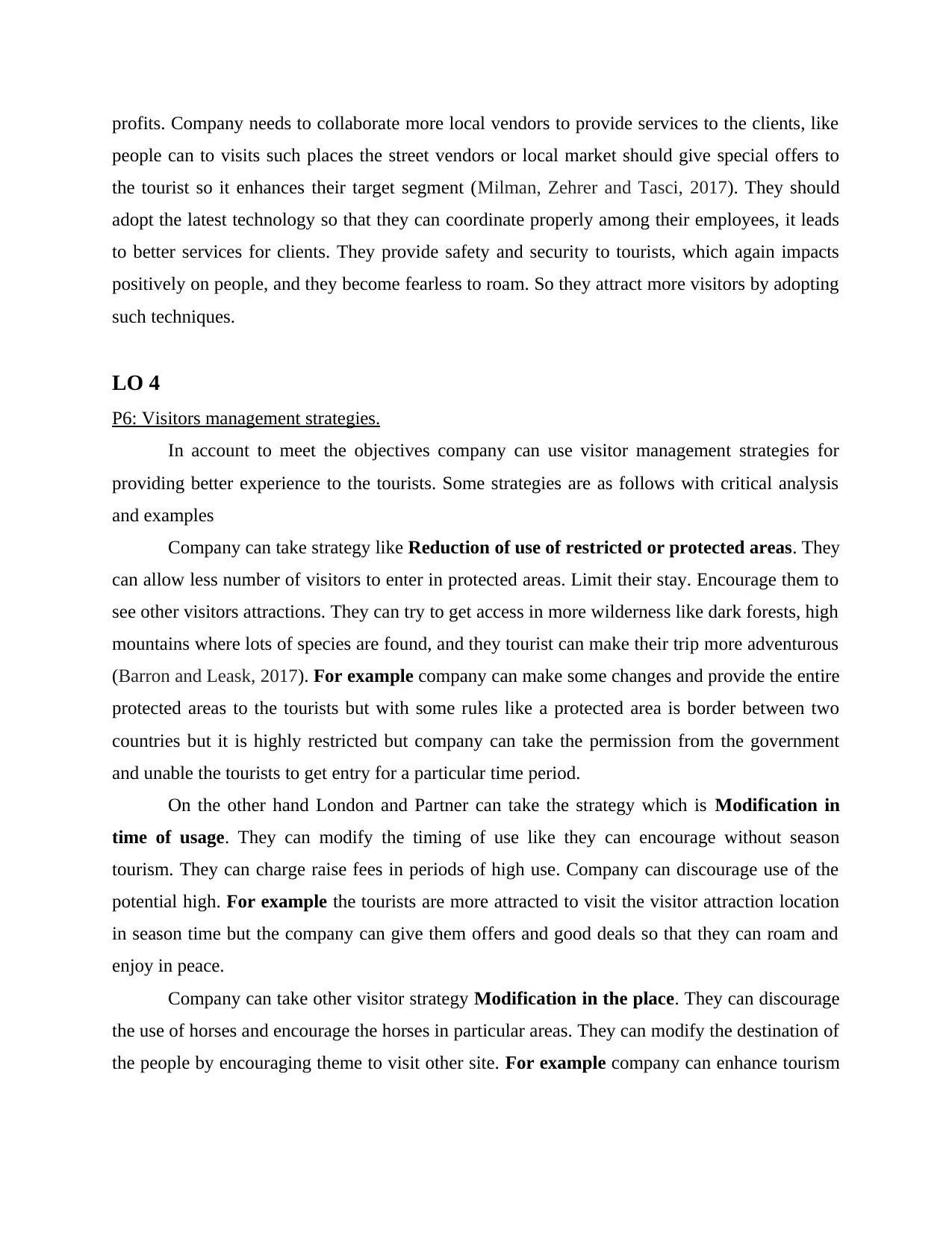
profits. Company needs to collaborate more local vendors to provide services to the clients, like
people can to visits such places the street vendors or local market should give special offers to
the tourist so it enhances their target segment (Milman, Zehrer and Tasci, 2017). They should
adopt the latest technology so that they can coordinate properly among their employees, it leads
to better services for clients. They provide safety and security to tourists, which again impacts
positively on people, and they become fearless to roam. So they attract more visitors by adopting
such techniques.
LO 4
P6: Visitors management strategies.
In account to meet the objectives company can use visitor management strategies for
providing better experience to the tourists. Some strategies are as follows with critical analysis
and examples
Company can take strategy like Reduction of use of restricted or protected areas. They
can allow less number of visitors to enter in protected areas. Limit their stay. Encourage them to
see other visitors attractions. They can try to get access in more wilderness like dark forests, high
mountains where lots of species are found, and they tourist can make their trip more adventurous
(Barron and Leask, 2017). For example company can make some changes and provide the entire
protected areas to the tourists but with some rules like a protected area is border between two
countries but it is highly restricted but company can take the permission from the government
and unable the tourists to get entry for a particular time period.
On the other hand London and Partner can take the strategy which is Modification in
time of usage. They can modify the timing of use like they can encourage without season
tourism. They can charge raise fees in periods of high use. Company can discourage use of the
potential high. For example the tourists are more attracted to visit the visitor attraction location
in season time but the company can give them offers and good deals so that they can roam and
enjoy in peace.
Company can take other visitor strategy Modification in the place. They can discourage
the use of horses and encourage the horses in particular areas. They can modify the destination of
the people by encouraging theme to visit other site. For example company can enhance tourism
people can to visits such places the street vendors or local market should give special offers to
the tourist so it enhances their target segment (Milman, Zehrer and Tasci, 2017). They should
adopt the latest technology so that they can coordinate properly among their employees, it leads
to better services for clients. They provide safety and security to tourists, which again impacts
positively on people, and they become fearless to roam. So they attract more visitors by adopting
such techniques.
LO 4
P6: Visitors management strategies.
In account to meet the objectives company can use visitor management strategies for
providing better experience to the tourists. Some strategies are as follows with critical analysis
and examples
Company can take strategy like Reduction of use of restricted or protected areas. They
can allow less number of visitors to enter in protected areas. Limit their stay. Encourage them to
see other visitors attractions. They can try to get access in more wilderness like dark forests, high
mountains where lots of species are found, and they tourist can make their trip more adventurous
(Barron and Leask, 2017). For example company can make some changes and provide the entire
protected areas to the tourists but with some rules like a protected area is border between two
countries but it is highly restricted but company can take the permission from the government
and unable the tourists to get entry for a particular time period.
On the other hand London and Partner can take the strategy which is Modification in
time of usage. They can modify the timing of use like they can encourage without season
tourism. They can charge raise fees in periods of high use. Company can discourage use of the
potential high. For example the tourists are more attracted to visit the visitor attraction location
in season time but the company can give them offers and good deals so that they can roam and
enjoy in peace.
Company can take other visitor strategy Modification in the place. They can discourage
the use of horses and encourage the horses in particular areas. They can modify the destination of
the people by encouraging theme to visit other site. For example company can enhance tourism
Paraphrase This Document
Need a fresh take? Get an instant paraphrase of this document with our AI Paraphraser
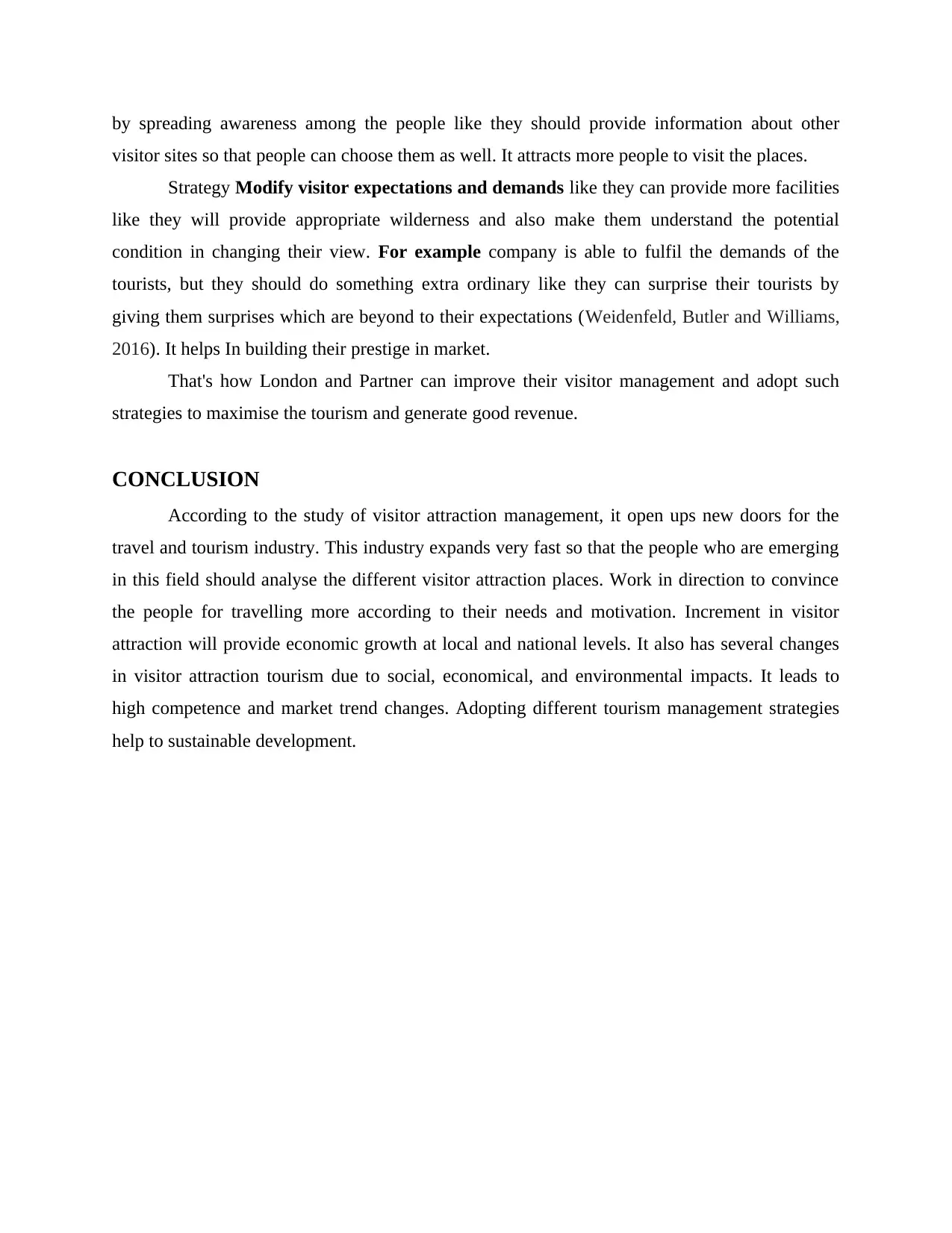
by spreading awareness among the people like they should provide information about other
visitor sites so that people can choose them as well. It attracts more people to visit the places.
Strategy Modify visitor expectations and demands like they can provide more facilities
like they will provide appropriate wilderness and also make them understand the potential
condition in changing their view. For example company is able to fulfil the demands of the
tourists, but they should do something extra ordinary like they can surprise their tourists by
giving them surprises which are beyond to their expectations (Weidenfeld, Butler and Williams,
2016). It helps In building their prestige in market.
That's how London and Partner can improve their visitor management and adopt such
strategies to maximise the tourism and generate good revenue.
CONCLUSION
According to the study of visitor attraction management, it open ups new doors for the
travel and tourism industry. This industry expands very fast so that the people who are emerging
in this field should analyse the different visitor attraction places. Work in direction to convince
the people for travelling more according to their needs and motivation. Increment in visitor
attraction will provide economic growth at local and national levels. It also has several changes
in visitor attraction tourism due to social, economical, and environmental impacts. It leads to
high competence and market trend changes. Adopting different tourism management strategies
help to sustainable development.
visitor sites so that people can choose them as well. It attracts more people to visit the places.
Strategy Modify visitor expectations and demands like they can provide more facilities
like they will provide appropriate wilderness and also make them understand the potential
condition in changing their view. For example company is able to fulfil the demands of the
tourists, but they should do something extra ordinary like they can surprise their tourists by
giving them surprises which are beyond to their expectations (Weidenfeld, Butler and Williams,
2016). It helps In building their prestige in market.
That's how London and Partner can improve their visitor management and adopt such
strategies to maximise the tourism and generate good revenue.
CONCLUSION
According to the study of visitor attraction management, it open ups new doors for the
travel and tourism industry. This industry expands very fast so that the people who are emerging
in this field should analyse the different visitor attraction places. Work in direction to convince
the people for travelling more according to their needs and motivation. Increment in visitor
attraction will provide economic growth at local and national levels. It also has several changes
in visitor attraction tourism due to social, economical, and environmental impacts. It leads to
high competence and market trend changes. Adopting different tourism management strategies
help to sustainable development.
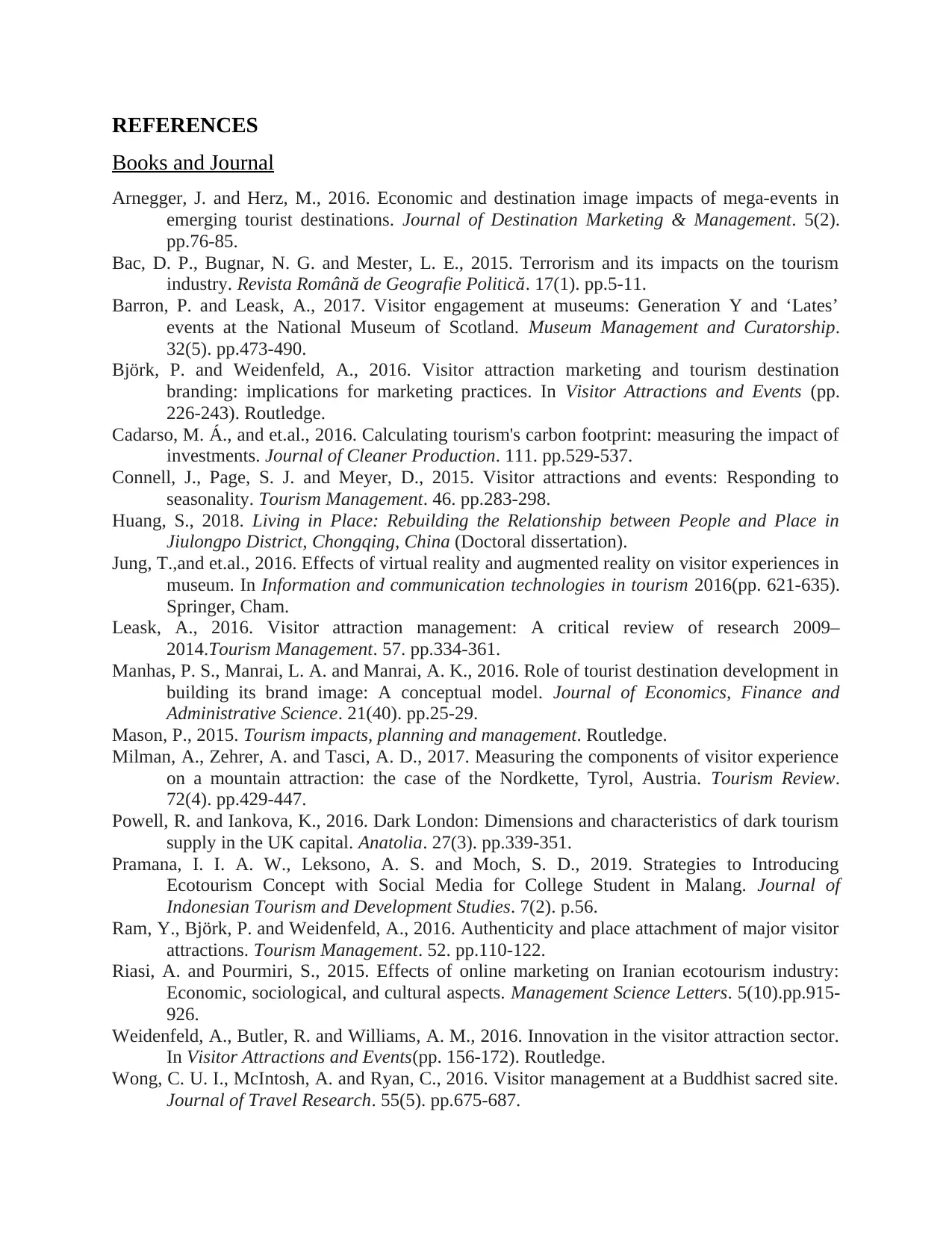
REFERENCES
Books and Journal
Arnegger, J. and Herz, M., 2016. Economic and destination image impacts of mega-events in
emerging tourist destinations. Journal of Destination Marketing & Management. 5(2).
pp.76-85.
Bac, D. P., Bugnar, N. G. and Mester, L. E., 2015. Terrorism and its impacts on the tourism
industry. Revista Română de Geografie Politică. 17(1). pp.5-11.
Barron, P. and Leask, A., 2017. Visitor engagement at museums: Generation Y and ‘Lates’
events at the National Museum of Scotland. Museum Management and Curatorship.
32(5). pp.473-490.
Björk, P. and Weidenfeld, A., 2016. Visitor attraction marketing and tourism destination
branding: implications for marketing practices. In Visitor Attractions and Events (pp.
226-243). Routledge.
Cadarso, M. Á., and et.al., 2016. Calculating tourism's carbon footprint: measuring the impact of
investments. Journal of Cleaner Production. 111. pp.529-537.
Connell, J., Page, S. J. and Meyer, D., 2015. Visitor attractions and events: Responding to
seasonality. Tourism Management. 46. pp.283-298.
Huang, S., 2018. Living in Place: Rebuilding the Relationship between People and Place in
Jiulongpo District, Chongqing, China (Doctoral dissertation).
Jung, T.,and et.al., 2016. Effects of virtual reality and augmented reality on visitor experiences in
museum. In Information and communication technologies in tourism 2016(pp. 621-635).
Springer, Cham.
Leask, A., 2016. Visitor attraction management: A critical review of research 2009–
2014.Tourism Management. 57. pp.334-361.
Manhas, P. S., Manrai, L. A. and Manrai, A. K., 2016. Role of tourist destination development in
building its brand image: A conceptual model. Journal of Economics, Finance and
Administrative Science. 21(40). pp.25-29.
Mason, P., 2015. Tourism impacts, planning and management. Routledge.
Milman, A., Zehrer, A. and Tasci, A. D., 2017. Measuring the components of visitor experience
on a mountain attraction: the case of the Nordkette, Tyrol, Austria. Tourism Review.
72(4). pp.429-447.
Powell, R. and Iankova, K., 2016. Dark London: Dimensions and characteristics of dark tourism
supply in the UK capital. Anatolia. 27(3). pp.339-351.
Pramana, I. I. A. W., Leksono, A. S. and Moch, S. D., 2019. Strategies to Introducing
Ecotourism Concept with Social Media for College Student in Malang. Journal of
Indonesian Tourism and Development Studies. 7(2). p.56.
Ram, Y., Björk, P. and Weidenfeld, A., 2016. Authenticity and place attachment of major visitor
attractions. Tourism Management. 52. pp.110-122.
Riasi, A. and Pourmiri, S., 2015. Effects of online marketing on Iranian ecotourism industry:
Economic, sociological, and cultural aspects. Management Science Letters. 5(10).pp.915-
926.
Weidenfeld, A., Butler, R. and Williams, A. M., 2016. Innovation in the visitor attraction sector.
In Visitor Attractions and Events(pp. 156-172). Routledge.
Wong, C. U. I., McIntosh, A. and Ryan, C., 2016. Visitor management at a Buddhist sacred site.
Journal of Travel Research. 55(5). pp.675-687.
Books and Journal
Arnegger, J. and Herz, M., 2016. Economic and destination image impacts of mega-events in
emerging tourist destinations. Journal of Destination Marketing & Management. 5(2).
pp.76-85.
Bac, D. P., Bugnar, N. G. and Mester, L. E., 2015. Terrorism and its impacts on the tourism
industry. Revista Română de Geografie Politică. 17(1). pp.5-11.
Barron, P. and Leask, A., 2017. Visitor engagement at museums: Generation Y and ‘Lates’
events at the National Museum of Scotland. Museum Management and Curatorship.
32(5). pp.473-490.
Björk, P. and Weidenfeld, A., 2016. Visitor attraction marketing and tourism destination
branding: implications for marketing practices. In Visitor Attractions and Events (pp.
226-243). Routledge.
Cadarso, M. Á., and et.al., 2016. Calculating tourism's carbon footprint: measuring the impact of
investments. Journal of Cleaner Production. 111. pp.529-537.
Connell, J., Page, S. J. and Meyer, D., 2015. Visitor attractions and events: Responding to
seasonality. Tourism Management. 46. pp.283-298.
Huang, S., 2018. Living in Place: Rebuilding the Relationship between People and Place in
Jiulongpo District, Chongqing, China (Doctoral dissertation).
Jung, T.,and et.al., 2016. Effects of virtual reality and augmented reality on visitor experiences in
museum. In Information and communication technologies in tourism 2016(pp. 621-635).
Springer, Cham.
Leask, A., 2016. Visitor attraction management: A critical review of research 2009–
2014.Tourism Management. 57. pp.334-361.
Manhas, P. S., Manrai, L. A. and Manrai, A. K., 2016. Role of tourist destination development in
building its brand image: A conceptual model. Journal of Economics, Finance and
Administrative Science. 21(40). pp.25-29.
Mason, P., 2015. Tourism impacts, planning and management. Routledge.
Milman, A., Zehrer, A. and Tasci, A. D., 2017. Measuring the components of visitor experience
on a mountain attraction: the case of the Nordkette, Tyrol, Austria. Tourism Review.
72(4). pp.429-447.
Powell, R. and Iankova, K., 2016. Dark London: Dimensions and characteristics of dark tourism
supply in the UK capital. Anatolia. 27(3). pp.339-351.
Pramana, I. I. A. W., Leksono, A. S. and Moch, S. D., 2019. Strategies to Introducing
Ecotourism Concept with Social Media for College Student in Malang. Journal of
Indonesian Tourism and Development Studies. 7(2). p.56.
Ram, Y., Björk, P. and Weidenfeld, A., 2016. Authenticity and place attachment of major visitor
attractions. Tourism Management. 52. pp.110-122.
Riasi, A. and Pourmiri, S., 2015. Effects of online marketing on Iranian ecotourism industry:
Economic, sociological, and cultural aspects. Management Science Letters. 5(10).pp.915-
926.
Weidenfeld, A., Butler, R. and Williams, A. M., 2016. Innovation in the visitor attraction sector.
In Visitor Attractions and Events(pp. 156-172). Routledge.
Wong, C. U. I., McIntosh, A. and Ryan, C., 2016. Visitor management at a Buddhist sacred site.
Journal of Travel Research. 55(5). pp.675-687.
⊘ This is a preview!⊘
Do you want full access?
Subscribe today to unlock all pages.

Trusted by 1+ million students worldwide
1 out of 13
Related Documents
Your All-in-One AI-Powered Toolkit for Academic Success.
+13062052269
info@desklib.com
Available 24*7 on WhatsApp / Email
![[object Object]](/_next/static/media/star-bottom.7253800d.svg)
Unlock your academic potential
Copyright © 2020–2025 A2Z Services. All Rights Reserved. Developed and managed by ZUCOL.





